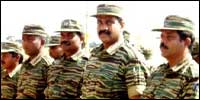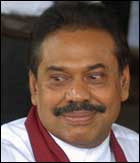
Tigers checkmate
[TamilNet, Wednesday, 09 August 2006, 10:05 GMT]
The Liberation Tigers' announcement that they would regard continued ground and air attacks by the Sri Lanka armed forces as declaration of war by Colombo, is an ominous development in Sri Lanka's continuing undeclared war. In addition to forcing the Government of Sri Lanka to choose between war and peace, Tigers have demonstrated their readiness to open multiple battlefronts in other strategic locations of the island to effectively counter the objectives of Sri Lankan military signified by the Trincomalee offensive.

Col. Sornam and his commanders
A military power equilibrium between the armed forces of the Government of Sri Lanka (GoSL) and the Liberation Tigers of Tamil Eelam (LTTE), achieved in Eelam War III, laid the foundation for the February 2002 Ceasefire Agreement (CFA) between the parties.
The balance of power was achieved as a result of LTTE winning key strategic battles in the NorthEast and executing successful military operations in the South.
"It was not the number of Tiger forces that decided the kind of Tiger victories. LTTE's capability to carry out strategic operations, counter-operations and sustain control of large territory, relied on qualitative military prowess rather than numbers," says Selvam Adaikalanthan, Vanni MP, who recently returned from a trip to EU countries.
When the LTTE's defence was compromised at a battlefront, LTTE will open one or more new fronts, forcing the fighting enemy's focus on multiple fronts, disabling enemy's efforts to concentrate on a single battlefront.
The Tiger maneuvers, including the ability to bait and divert enemy's attention, maintain a top level of secrecy to confuse the enemy, work with single-mindedness to establish a position of strength, decide the appropriate time to strike with overwhelming speed and firepower, form the foundation of LTTE's counter-offensive strength.
While sustaining the CeaseFire Agreement (CFA) LTTE is handicapped to deploy its full maneuvering ability. A full scale war is a pre-requisite to defend and execute successful offensives and counter-offensives with LTTE's art of warfare maneuvering.
Tigers avoided keeping ground control of Muthur for this reason. The operation on Muthur was not intended to capture territory. It was a military pressure, as LTTE's military spokesman Ilanthirayan outlined from the beginning.
Counter-offensive dimensions of LTTE defense were showcased in the Muthur operation last week when Tiger Commander Col. Sornam stole the position of advantage from the Sri Lankan armed forces that had launched a three-month-long campaign of bombardment, blockade and finally a ground operation, named "Operation Watershed," aiming to thwart the Tiger control from the southern sector of Trincomalee.
Tommy Lekenmyr, the Swedish chief of staff for the Sri Lanka Monitoring Mission (SLMM) told the press that it was "quite obvious they [GoSL] are not interested in water. They are interested in something else. We blame this on the government."

Col. Sornam [right] shaking hands with the late Maj. Gen. Trond Furuhovde, the first Head of Mission, SLMM.
The Tiger Commander Sornam, launched artillery attack on Trincomalee naval base on August 01 and sent his strike force early morning the following day at 2:00 a.m. in a fast outmaneuvering operation through Muthur, accomplishing the mission in less than 72 hours midnight August 05 before Colombo managed to mass its troops with additional firepower towards Muthur.
It was clear that to face a "regional offensive," in Trincomalee district, and to conduct the kind of offensive with battle-experienced troopers, Colombo needed, and had to summon hurriedly additional troopers from other districts.
As it became apparent, Colombo was not prepared in terms of number of troops to face the kind of outmaneuvering counter-offensive by the Tigers in Muthur, even though the Sri Lanka military had planned and executed the offensive for more than three months.
The speed of Tiger offensive did not allow the Sri Lankan troops to concentrate and gain necessary superiority in terms of ground troops and firepower in time, and the Tigers returned to CFA positions before the Sri Lankan military establishment managed bring to the battle theatre the needed troops.

Second batch of Rural Volunteers Brigade passing out in Muthur East
As the Tigers proved their case, the status-quo was established, resulting in a stalemated Trincomalee, sustained the CFA under Muthur counter-offensive, and finally pre-empted the stated goal of the Sri Lankan offensive towards Maavilaru.
At the end of demonstrating the balance of power, once again, the Tigers have said they would view continued artillery attacks as proclamation of war by the GoSL.
And the Tigers delivered a clear warning to Sri Lanka Government when they told SLMM monitors and the facilitators that continued attacks and offensive would set the scene for Eelam War IV.

Sri Lankan President Mahinda Rajapakse is the Commander-in-Chief of armed forces.
The Muthur battle raised the key question whether Colombo, and the Sri Lankan President Mahinda Rajapakse, the Commander-in-Chief of its armed forces, would want to choose peace or war. If Rajapakse, as C-in-C, opts for continuing the offensive, he would have declared war.
If he accedes with and supports Norwegian facilitators efforts in time, he would have saved the island from a deadly war.
Military analysts with insight in the demography of NorthEast point out that the Tigers would need to open multiple fronts to route the Sri Lankan offensive, if the offensive continued. LTTE's threat of Eelam War IV indicated that LTTE is prepared for this military imperative.
This would mean the end of four and a half year of Ceasefire, and that the future trajectory of Sri Lanka's path towards war is now in the hands of Mahinda Rajapakse.











